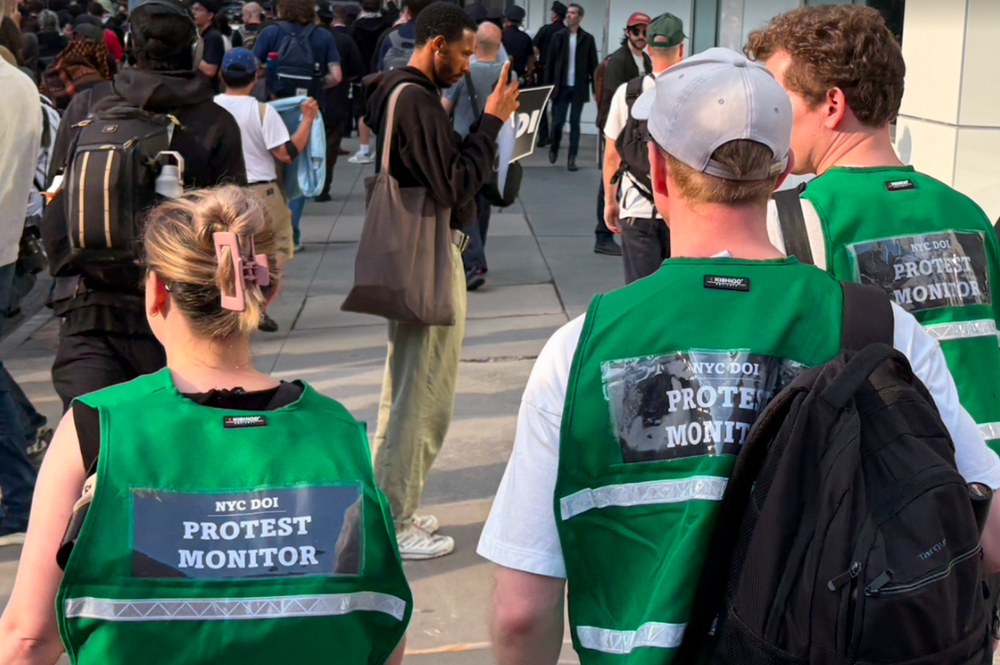The NYPD is being monitored at anti-ICE protests after recent George Floyd settlement
June 11, 2025, 4:39 p.m.
Three DOI monitors walked alongside demonstrators at an anti-ICE protest on Tuesday.

Officials from the New York City Department of Investigation have been monitoring the NYPD's response to anti-ICE demonstrations this week as part of a legal agreement reached after demonstrators in 2020 claimed police illegally arrested them as they protested the killing of George Floyd.
Three DOI protest monitors walked along a large crowd of anti-ICE protesters on Tuesday as they marched through the street in Lower Manhattan. The monitors declined to speak to Gothamist about their role at the demonstration.
But DOI spokesperson Diane Struzzi said the agency dispatched the monitors as part of a legal settlement after the 2020 protests.
The settlement came in response to claims by the Legal Aid Society, New York Civil Liberties Union, private attorneys and the attorney general’s office accusing officers of reacting aggressively to demonstrations, using batons to club demonstrators and forcing large groups of demonstrators into pens to carry out mass arrests.
This week, protesters have flooded the streets of Manhattan to demonstrate against President Donald Trump’s immigration crackdown.
On Tuesday, a large group marched peacefully from Lower Manhattan to Washington Square Park. But a group that splintered off from the march clashed with officers near a federal building, where the NYPD arrested more than 80 people.
Gothamist also saw observers from the New York Civil Liberties Union at the protest.
As part of the settlement, the DOI will chair a “collaborative committee” that will review the NYPD’s response to certain demonstrations in the city. Struzzi said the committee's work has not yet begun. She did not immediately say when the committee is scheduled to begin work.
“DOI’s monitors are attending protests in preparation for that phase of the settlement,” Struzzi said in an email.
When it launches, the committee is supposed to meet every six months to review how NYPD officers respond to certain protests in the city, according to the settlement. Committee members will pre-select the protests monitors will review.
The NYPD will be required to give DOI materials related to the selected protests; the settlement does not specify what materials will have to be turned over.
They will also need to make officers available for interviews, according to the agreement.
The committee will be made up of officials from DOI, the NYPD, the attorney general’s office and others associated with the lawsuits, according to the settlement.
The NYPD did not immediately respond to a request for comment about the monitors that attended the protest.
The protest on Tuesday came after large demonstrations broke out in Los Angeles and surrounding cities over the weekend. That city’s protests at times turned violent, with some demonstrators hurling rocks and other objects at police officers.
The Trump administration responded by deploying National Guard troops to the city, over the objection of Gov. Gavin Newsom. The state has since sued the Trump administration for calling in the National Guard. In a speech Tuesday, Newsom said Trump’s decision to deploy troops over his objection was an assault on democracy.
On Tuesday evening, a large number of anti-ICE protesters gathered in Foley Square in lower Manhattan. A majority of the crowd then peacefully marched through the streets and made their way up to Washington Square Park.
A group of demonstrators that splintered off from the larger crowd on Tuesday night clashed with police officers near a federal office building near Foley Square, Police Commissioner Jessica Tisch said Wednesday. NYPD officers arrested 86 people during the unrest, Tisch said in an interview on FOX 5.
She added that there is no need for federal authorities to deploy in New York to keep peace on the streets.
“At the NYPD, we have this under control. We have plans in place,” she said. “We have an army of 34,000 uniformed members of the service in New York City.”
What do the LA protests against the Trump administration mean for New York City? NYC mayoral candidates weigh showdown with Trump as immigration protests intensify